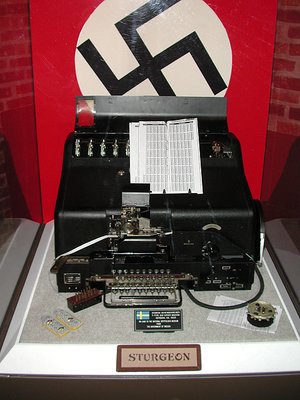Siemens and Halske T52
|
|

The Siemens and Halske T52, also known as the Geheimfernschreiber ("secret teleprinter"), was a World War II German teleprinter cipher machine. The machine and its traffic were codenamed Sturgeon by British cryptographers.
While the Enigma machine was generally used by field units, the T52 was used by Luftwaffe headquarters units, which could support the heavy machine, teletypewriter and attendant fixed circuits. It fulfilled a similar role to the Lorenz SZ 40/42 machine in the German Army. There were several incompatible versions of the T52. Following the occupation of Denmark and Norway Swedish mathematician and cryptographer, Arne Beurling cracked the two earliest models on two weeks in June 1940 using just pen and paper.
The British cryptographers of Bletchley Park codenamed the German teleprinter ciphers Fish. The T52 was called Sturgeon (the Lorenz machine was codenamed Tunny).
| Contents |
Operation
BP-T52.jpg
The teleprinters of the day emitted each character as five parallel bits on five lines, typically encoded in the Baudot code or something similar. The T52 had ten pinwheels, which were stepped in a complex, nonlinear way, based in later models on their positions from various delays in the past, but in such a way that they could never stall. Each of the five plaintext bits was then XORed with the XOR sum of 3 taps from the pinwheels, and then cyclically adjacent pairs of plaintext bits were swapped or not, according to XOR sums of three (different) output bits. The numbers of pins on all the wheels were coprime, and the triplets of bits that controlled each XOR or swap were selectable through a plugboard.
This produced a much more complex cipher than the Lorenz machine, and also means that the T52 is not just a pseudorandom number generator-and-XOR cipher. For example, if a cipher clerk erred and sent two different messages using exactly the same settings — a depth of two in Bletchley jargon — this could be detected statistically but was not immediately and trivially solvable as it would be with Lorenz.
Cryptanalysis
The British did not break Sturgeon as regularly as they broke Enigma or Tunny. Partly this was because the T52 was by far the most complex cipher of the three, but also because the Luftwaffe very often retransmitted Sturgeon messages using easier to attack (or already broken) ciphers; thus, attacking Sturgeon was not the most economical way to get the plaintext. T52 was produced in several versions: T52a, T52b, T52c and T52d. While T52a and T52b were weak, T52d was a more advanced device. Conceptual flaws including very subtle ones had been removed — one such flaw eliminated from earlier machines was the ability to reset the key which led to key-reuse by undisciplined machine operators.
Related topics
References
- D. Davies, The Siemens and Halske T52e Cipher Machine (reprinted in Cryptology: Yesterday, Today and Tomorrow, Artech House, Norwood, 1987)
- D. Davies, The Early Models of the Siemens and Halske T52 Cipher Machine (also reprinted in Cryptology: Yesterday, Today and Tomorrow)
- D. W. Davies, New Information on the History of the Siemens and Halske T52 Cipher Machines (reprinted in Selections from Cryptologia: History, People, and Technology, Artech House, Norwood, 1998)
External links
- John Savard's page on the Geheimfernschreiber (http://home.ecn.ab.ca/~jsavard/crypto/te0302.htm)
- Photographs of Sturgeon (http://www.jproc.ca/crypto/sturg.html)
- [1] (http://www.alanturing.net/turing_archive/archive/b/B06/BO6-085.html) Entry for "Sturgeon" in the GC&CS Cryptographic Dictionary
